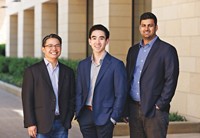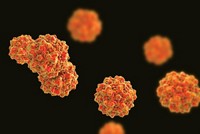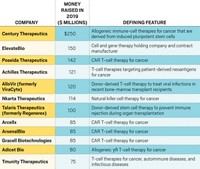Advertisement
Grab your lab coat. Let's get started
Welcome!
Welcome!
Create an account below to get 6 C&EN articles per month, receive newsletters and more - all free.
It seems this is your first time logging in online. Please enter the following information to continue.
As an ACS member you automatically get access to this site. All we need is few more details to create your reading experience.
Not you? Sign in with a different account.
Not you? Sign in with a different account.
ERROR 1
ERROR 1
ERROR 2
ERROR 2
ERROR 2
ERROR 2
ERROR 2
Password and Confirm password must match.
If you have an ACS member number, please enter it here so we can link this account to your membership. (optional)
ERROR 2
ACS values your privacy. By submitting your information, you are gaining access to C&EN and subscribing to our weekly newsletter. We use the information you provide to make your reading experience better, and we will never sell your data to third party members.
Biologics
Making stem cell transplants safer
Biotech firms hope less harsh, more effective conditioning therapies will expand the kinds of diseases treated by stem cell transplants
by Ryan Cross
April 18, 2021
| A version of this story appeared in
Volume 99, Issue 14

As a young pediatric oncologist, Kevin Heller was struck by the power of bone marrow transplants. While working at Memorial Sloan Kettering Cancer Center in the early 2000s, he saw how hematopoietic stem cells taken from a donor’s bone marrow and infused into children with blood cancer could save lives. But the process came at a cost. Before getting the transplant, the kids had to endure what doctors call conditioning, typically a combination of chemotherapy and radiotherapy that clears out diseased cells and makes space in the bone marrow for the incoming healthy ones.
“It is like giving a hard reset to these patients, but we had to bring these poor kids to the brink of death,” Heller says. The collateral damage caused by conditioning can be significant. Risks include severe infection, organ damage, developmental problems in young people, and infertility. And since the chemotherapies commonly used in conditioning damage DNA, the process can even trigger new cancers. Conditioning is “incredibly difficult” to endure, he says. “And there have been only minor steps of improvement.”
Last year, Heller, who eventually left academia to lead oncology teams at multiple drug companies, joined and became vice president of R&D at a start-up called Jasper Therapeutics, which is trying to make conditioning safer and more effective. It is one of a handful of companies—including Actinium Pharmaceuticals, Gilead Sciences, and Magenta Therapeutics—developing antibody-based therapies designed to selectively remove hematopoietic stem cells with fewer side effects than traditional conditioning.
If these targeted conditioning therapies prove successful, they could make stem cell transplants more attractive for treating a broader range of diseases—including ones like chronic autoimmune diseases or genetic disorders, in which the tolerance for dangerous side effects is much lower than it is for treating cancer. “I think there are a lot of patients who could benefit from stem cell transplantation, but physicians wouldn’t consider it because of the severe side effect profile and the incredible risk associated with conditioning,” Heller says.

Since hematopoietic stem cells give rise to all our blood and immune cells, stem cell transplants can, in theory, treat a bevy of conditions linked to those stem cells or their progeny. “Stem cell transplants cure patients. We know they work,” Magenta CEO Jason Gardner says. “But they are not used as often as they could be.” According to Magenta’s market research, only about 60% of people with cancer, 34% of people with genetic diseases, and 5% of people with autoimmune conditions who are eligible to get stem cell transplants actually undergo the procedure. And some people are ineligible because they are too weak to undergo the harsh conditioning.
Biotech companies are becoming more interested in targeted conditioning and alternatives to conditioning partly because of growing investments in gene-modified stem cells to treat genetic diseases such as hemophilia and sickle cell disease. “It is something that we think about a lot,” says Josh Lehrer, CEO of the new CRISPR gene-editing company Graphite Bio, which has partnered with Jasper to test its targeted conditioning therapy. “To even be compelling to a patient, you have to offer these kinds of curative therapies in a different way.”
Doctors first began using bone marrow transplants to try to reset people’s cancer-ridden blood systems more than 60 years ago. Resetting the system first required wiping it clean with chemotherapy and radiation, which sometimes led to deaths from the conditioning itself. Although doctors can tailor the level of conditioning depending on a person’s disease, the nuts and bolts of conditioning haven’t changed much in 20 years.
Researchers hope to make conditioning safer and gentler—or, in some cases, eliminate the need for it altogether. The most advanced efforts use antibodies to target proteins on the surface of hematopoietic stem cells and ultimately kill them. Two popular targets are proteins called CD45 and CD117.
Actinium is focused on targeting CD45 for conditioning for cancer and genetic diseases. Chief Scientific Officer Dale Ludwig says it is a good target because CD45 is found exclusively on hematopoietic stem cells and the immune cells they give rise to, not on red blood cells or platelets, which are also descendants of hematopoietic stem cells. Actinium’s CD45-targeted antibody is labeled with radioactive iodine (131I), which should provide a means to selectively deliver the radiation to, and thus kill, cells that have CD45 on their surface. The approach should have fewer side effects than traditional radiotherapy. Actinium is testing the antibody as a conditioning reagent for people with refractory or relapsed acute myeloid leukemia.
David Scadden, a Harvard University stem cell biologist and Magenta cofounder, thinks that CD117, which is found in abundance on hematopoietic stem cells and to a lesser extent on their progeny, is the best target for cancer and genetic diseases. He thinks CD45 is a better target for autoimmune diseases. Magenta is using its CD117-targeted antibody-drug conjugate to deliver a lethal, mushroom-derived toxin called amanitin to kill cells with CD117 on their surface. Jasper’s CD117-targeted antibody, which it licensed from Amgen, works by preventing a protein called stem cell factor from binding to CD117. That blockade weakens or kills the hematopoietic stem cells, Heller says.
These first iterations of targeted conditioning, mainly geared toward cancer, won’t completely eliminate traditional chemotherapy or radiation. Jasper and Magenta both plan on using reduced-intensity conditioning alongside their CD117-targeted antibodies, which simply means using smaller doses of chemotherapy, radiation, or both. When treating cancer, “you need to get every weed out,” Heller says.
Another potential problem is that CD117 is not restricted to hematopoietic stem cells. The protein is found on cells in other parts of the body, including in the skin, in the vascular system, and on germ cells. Targeted conditioning aimed at CD117 may not fully eliminate all serious side effects, including infertility. And even if targeted conditioning proves to be safer than traditional conditioning, the stem cell transplant itself is not guaranteed to work, and the method won’t eliminate transplant-associated risks such as immune rejection.
Some scientists are skeptical that targeted conditioning will ever be potent enough for blood cancer, and they caution that any lingering cells could cause the cancer to relapse. “Antibody-based targeted therapy needs some optimization, in my opinion,” says Monzr M. Al Malki, a cell transplant physician at City of Hope, a hospital and research center in Duarte, California. “But don’t misunderstand me, I believe that targeted conditioning is the future,” he says, adding that targeted conditioning can encompass more precise manipulation of chemotherapy and radiation. At City of Hope, he uses an experimental body-scanning approach called total marrow and lymphoid irradiation to channel radiation to the bone marrow and minimize damage to other organs.
The bigger opportunity for the antibody-based conditioning therapies might be in genetic diseases, where the weeding doesn’t need to be as complete as it does in blood cancers.
For a disease called severe combined immunodeficiency, in which babies are born without white blood cells, replacing as little as 1–2% of the hematopoietic stem cells could give the infant a properly functioning immune system. “The bar is fairly low there,” Lehrer says, and that’s why Graphite is testing Jasper’s CD117-targeted antibody in that condition first. For sickle cell disease, Lehrer says that his company is aiming to replace at least 20% of a person’s stem cells. For now, people joining Graphite’s clinical trial of its CRISPR-based sickle cell therapy will have to receive traditional conditioning, although Graphite may test Jasper’s antibody in a future study for its sickle cell program.
Actinium, Gilead, and Magenta also have partnerships with academic groups or biotech companies to test their targeted conditioning antibodies in gene therapy applications. But most companies with programs that transplant gene-modified stem cells still rely on traditional conditioning, typically with the chemotherapy busulfan, and not targeted conditioning.
In February, reports of two people who developed cancer years after receiving busulfan conditioning and Bluebird Bio’s gene therapy for sickle cell disease renewed concerns about the inherent risks of conditioning. Although Bluebird neither acquitted nor convicted busulfan as the cause of the cancer, genetic tests suggested that the cancer was not caused by gene therapy itself.
Busulfan, which damages DNA, is a known carcinogen, but some gene therapy firms think that experienced physicians can manage its risks. One difficulty is that people metabolize busulfan at wildly different rates, which makes precise dosing hard to achieve, says Chris Mason, chief scientific officer of Avrobio. His company collaborated with a blood diagnostics firm to make a kit that allows physicians to monitor and adjust the dose of busulfan that patients receive during conditioning.
A few groups are thinking about ways to circumvent conditioning altogether, at least for genetic diseases. A 2019 study from Hiromitsu Nakauchi, a stem cell biologist at Stanford University, upended the dogma that transplants won’t succeed without conditioning. His lab discovered a way to spur mouse hematopoietic stem cells to grow to nearly 900 times their original numbers under special conditions in a petri dish in under a month. Surprisingly, when the cells were transplanted back into a mouse, some of the cells engrafted in the bone marrow without any conditioning. He has started a company, called Celaid Therapeutics, to apply the idea to human stem cells too.
Another way to sidestep conditioning in gene therapy applications is to modify the stem cells directly in a person’s body rather than removing them, modifying them in a lab, and reinfusing them. Ensoma is one start-up in the early stages of designing viral vectors that deliver genes preferentially to hematopoietic stem cells. “This could be done in an outpatient clinic,” no conditioning required, says Ensoma’s executive chairman, Paula Soteropoulos. Jasper is also exploring ways to engineer stem cells that “outpace existing stem cells in the patient” and engraft without the need for conditioning, according to Heller.
Although targeted conditioning therapies are still experimental, researchers are excited about the prospect of reducing, and maybe someday eliminating, the risks that come with conditioning. “Gene therapy itself has some attendant risk, but you’d love to not have to add on to that,” Harvard’s Scadden says. Without the risk of conditioning, “it becomes a very different conversation between the physician and the patient and their family. You can start talking more about the cure and less about the complications.”





Join the conversation
Contact the reporter
Submit a Letter to the Editor for publication
Engage with us on Twitter